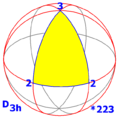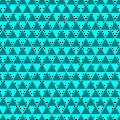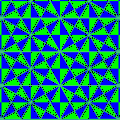Schwarz triangle
In geometry, a Schwarz triangle, named after Hermann Schwarz, is a spherical triangle that can be used to tile a sphere, possibly overlapping, through reflections in its edges. They were classified in (Schwarz 1873).
These can be defined more generally as tessellations of the sphere, the Euclidean plane, or the hyperbolic plane. Each Schwarz triangle on a sphere defines a finite group, while on the Euclidean or hyperbolic plane they define an infinite group.
A Schwarz triangle is represented by three rational numbers (p q r) each representing the angle at a vertex. The value n/d means the vertex angle is d/n of the half-circle. "2" means a right triangle. When these are whole numbers, the triangle is called a Möbius triangle, and corresponds to a non-overlapping tiling, and the symmetry group is called a triangle group. In the sphere there are three Möbius triangles plus one one-parameter family; in the plane there are three Möbius triangles, while in hyperbolic space there is a three-parameter family of Möbius triangles, and no exceptional objects.
Solution space
A fundamental domain triangle (p q r), with vertex angles π/p, π/q, and π/r, can exist in different spaces depending on the value of the sum of the reciprocals of these integers:
This is simply a way of saying that in Euclidean space the interior angles of a triangle sum to π, while on a sphere they sum to an angle greater than π, and on hyperbolic space they sum to less.
Graphical representation
A Schwarz triangle is represented graphically by a triangular graph. Each node represents an edge (mirror) of the Schwarz triangle. Each edge is labeled by a rational value corresponding to the reflection order, being π/vertex angle.
 Schwarz triangle (p q r) on sphere |
 Schwarz triangle graph |
Order-2 edges represent perpendicular mirrors that can be ignored in this diagram. The Coxeter-Dynkin diagram represents this triangular graph with order-2 edges hidden.
A Coxeter group can be used for a simpler notation, as (p q r) for cyclic graphs, and (p q 2) = [p,q] for (right triangles), and (p 2 2) = [p]×[].
A list of Schwarz triangles
Möbius triangles for the sphere
 (2 2 2) or [2,2] |
 (3 2 2) or [3,2] |
... |
|---|---|---|
 (3 3 2) or [3,3] |
 (4 3 2) or [4,3] |
 (5 3 2) or [5,3] |
Schwarz triangles with whole numbers, also called Möbius triangles, include one 1-parameter family and three exceptional cases:
- [p,2] or (p 2 2) – Dihedral symmetry,





- [3,3] or (3 3 2) – Tetrahedral symmetry,





- [4,3] or (4 3 2) – Octahedral symmetry,





- [5,3] or (5 3 2) – Icosahedral symmetry,





Schwarz triangles for the sphere by density
The Schwarz triangles (p q r), grouped by density:
| Density | Dihedral | Tetrahedral | Octahedral | Icosahedral |
|---|---|---|---|---|
| d | (2 2 n/d) | |||
| 1 | (2 3 3) | (2 3 4) | (2 3 5) | |
| 2 | (3/2 3 3) | (3/2 4 4) | (3/2 5 5), (5/2 3 3) | |
| 3 | (2 3/2 3) | (2 5/2 5) | ||
| 4 | (3 4/3 4) | (3 5/3 5) | ||
| 5 | (2 3/2 3/2) | (2 3/2 4) | ||
| 6 | (3/2 3/2 3/2) | (5/2 5/2 5/2), (3/2 3 5), (5/4 5 5) | ||
| 7 | (2 3 4/3) | (2 3 5/2) | ||
| 8 | (3/2 5/2 5) | |||
| 9 | (2 5/3 5) | |||
| 10 | (3 5/3 5/2), (3 5/4 5) | |||
| 11 | (2 3/2 4/3) | (2 3/2 5) | ||
| 13 | (2 3 5/3) | |||
| 14 | (3/2 4/3 4/3) | (3/2 5/2 5/2), (3 3 5/4) | ||
| 16 | (3 5/4 5/2) | |||
| 17 | (2 3/2 5/2) | |||
| 18 | (3/2 3 5/3), (5/3 5/3 5/2) | |||
| 19 | (2 3 5/4) | |||
| 21 | (2 5/4 5/2) | |||
| 22 | (3/2 3/2 5/2) | |||
| 23 | (2 3/2 5/3) | |||
| 26 | (3/2 5/3 5/3) | |||
| 27 | (2 5/4 5/3) | |||
| 29 | (2 3/2 5/4) | |||
| 32 | (3/2 5/4 5/3) | |||
| 34 | (3/2 3/2 5/4) | |||
| 38 | (3/2 5/4 5/4) | |||
| 42 | (5/4 5/4 5/4) |
Triangles for the Euclidean plane
 (3 3 3) |
 (4 4 2) |
 (6 3 2) |
Density 1:
- (3 3 3) – 60-60-60 (equilateral),



- (4 4 2) – 45-45-90 (isosceles right),





- (6 3 2) – 30-60-90,





Density 2:
- (6 6 3/2) - 120-30-30 triangle
Density ∞:
- (4 4/3 ∞)
- (3 3/2 ∞)
- (6 6/5 ∞)
Triangles for the hyperbolic plane
 (7 3 2) |
 (8 3 2) |
 (5 4 2) |
 (4 3 3) |
 (4 4 3) |
 (∞ ∞ ∞) |
| Fundamental domains of (p q r) triangles | ||
Density 1:
- (2 3 7), (2 3 8), (2 3 9) ... (2 3 ∞)
- (2 4 5), (2 4 6), (2 4 7) ... (2 4 ∞)
- (2 5 5), (2 5 6), (2 5 7) ... (2 5 ∞)
- (2 6 6), (2 6 7), (2 6 8) ... (2 6 ∞)
- (3 3 4), (3 3 5), (3 3 6) ... (3 3 ∞)
- (3 4 4), (3 4 5), (3 4 6) ... (3 4 ∞)
- (3 5 5), (3 5 6), (3 5 7) ... (3 5 ∞)
- (3 6 6), (3 6 7), (3 6 8) ... (3 6 ∞)
- ...
- (∞ ∞ ∞)
Density 2:
- (3/2 7 7), (3/2 8 8), (3/2 9 9) ... (3/2 ∞ ∞)
- (5/2 4 4), (5/2 5 5), (5/2 6 6) ... (5/2 ∞ ∞)
- (7/2 3 3), (7/2 4 4), (7/2 5 5) ... (7/2 ∞ ∞)
- (9/2 3 3), (9/2 4 4), (9/2 5 5) ... (9/2 ∞ ∞)
- ...
Density 3:
- (2 7/2 7), (2 9/2 9), (2 11/2 11) ...
Density 4:
- (7/3 3 7), (8/3 3 8), (3 10/3 10), (3 11/3 11) ...
Density 6:
- (7/4 7 7), (9/4 9 9), (11/4 11 11) ...
Density 10:
- (3 7/2 7)
The (2 3 7) Schwarz triangle is the smallest hyperbolic Schwarz triangle, and as such is of particular interest. Its triangle group (or more precisely the index 2 von Dyck group of orientation-preserving isometries) is the (2,3,7) triangle group, which is the universal group for all Hurwitz groups – maximal groups of isometries of Riemann surfaces. All Hurwitz groups are quotients of the (2,3,7) triangle group, and all Hurwitz surfaces are tiled by the (2,3,7) Schwarz triangle. The smallest Hurwitz group is the simple group of order 168, the second smallest non-abelian simple group, which is isomorphic to PSL(2,7), and the associated Hurwitz surface (of genus 3) is the Klein quartic.
The (2 3 8) triangle tiles the Bolza surface, a highly symmetric (but not Hurwitz) surface of genus 2.
The triangles with one noninteger angle, listed above, were first classified by Anthony W. Knapp in.[1] A list of triangles with multiple noninteger angles is given in.[2]
See also
- List of uniform polyhedra by Schwarz triangle
- Wythoff symbol
- Wythoff construction
- Uniform polyhedron
- Nonconvex uniform polyhedron
- Density (polytope)
- Goursat tetrahedron
- Regular hyperbolic tiling
- Uniform tilings in hyperbolic plane
References
- ^ A. W. Knapp, Doubly generated Fuchsian groups, Michigan Mathematics Journal 15 (1968), no. 3, 289–304
- ^ Klimenko and Sakuma, Two-generator discrete subgroups of Isom( H 2 ) containing orientation-reversing elements, Geometriae Dedicata October 1998, Volume 72, Issue 3, pp 247-282
- Coxeter, Regular Polytopes, Third edition, (1973), Dover edition, ISBN 0-486-61480-8 (Table 3: Schwarz's Triangles)
- Schwarz, H. A. (1873), "Ueber diejenigen Fälle in welchen die Gaussichen hypergeometrische Reihe eine algebraische Function ihres vierten Elementes darstellt", Journal für die reine und angewandte Mathematik, 75: 292–335, doi:10.1515/crll.1873.75.292, ISSN 0075-4102 (Note that Coxeter references this as "Zur Theorie der hypergeometrischen Reihe", which is the short title used in the journal page headers).
- Wenninger, Magnus J. (1979), "An introduction to the notion of polyhedral density", Spherical models, CUP Archive, pp. 132–134, ISBN 978-0-521-22279-2

![{\displaystyle {\begin{aligned}{\frac {1}{p}}+{\frac {1}{q}}+{\frac {1}{r}}&>1{\text{ : Sphere}}\\[8pt]{\frac {1}{p}}+{\frac {1}{q}}+{\frac {1}{r}}&=1{\text{ : Euclidean plane}}\\[8pt]{\frac {1}{p}}+{\frac {1}{q}}+{\frac {1}{r}}&<1{\text{ : Hyperbolic plane}}\end{aligned}}}](https://wikimedia.org/api/rest_v1/media/math/render/svg/38035eea807c70c16a4af78d06e01c817876703f)

